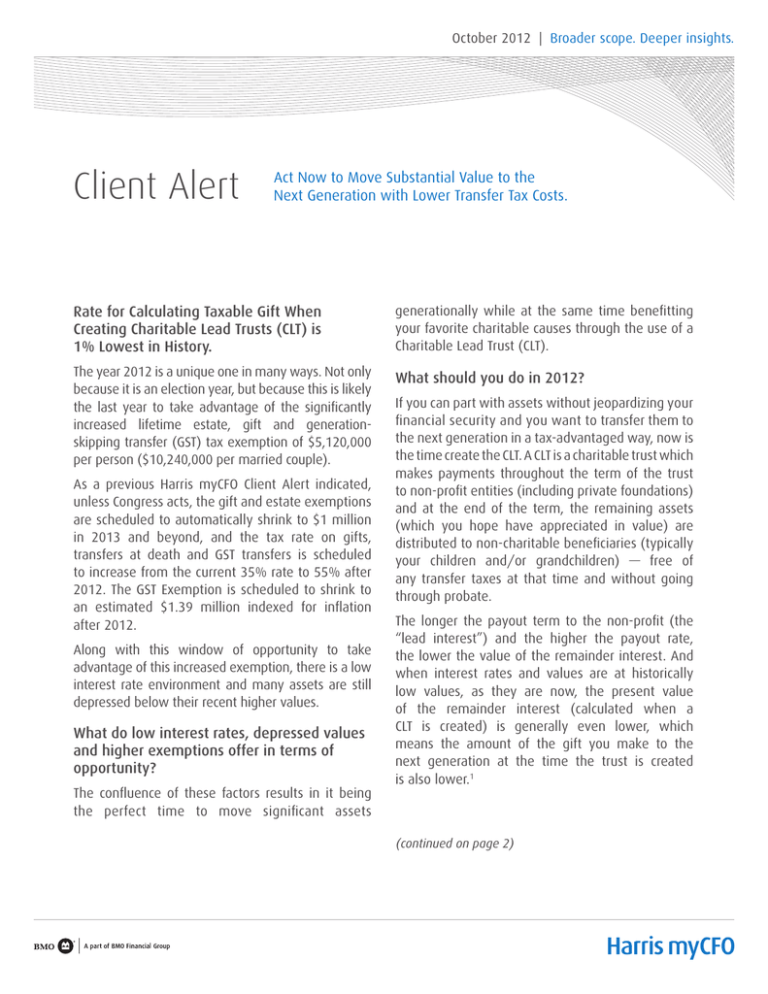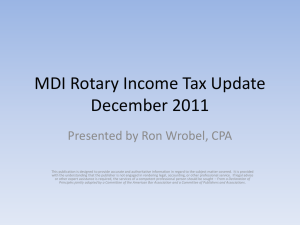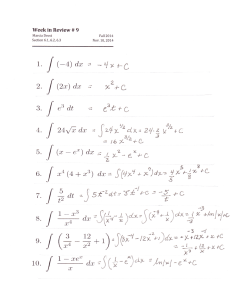Client Alert
advertisement

October 2012 | Broader scope. Deeper insights. Client Alert Act Now to Move Substantial Value to the Next Generation with Lower Transfer Tax Costs. Rate for Calculating Taxable Gift When Creating Charitable Lead Trusts (CLT) is 1% Lowest in History. generationally while at the same time benefitting your favorite charitable causes through the use of a Charitable Lead Trust (CLT). The year 2012 is a unique one in many ways. Not only because it is an election year, but because this is likely the last year to take advantage of the significantly increased lifetime estate, gift and generationskipping transfer (GST) tax exemption of $5,120,000 per person ($10,240,000 per married couple). What should you do in 2012? As a previous Harris myCFO Client Alert indicated, unless Congress acts, the gift and estate exemptions are scheduled to automatically shrink to $1 million in 2013 and beyond, and the tax rate on gifts, transfers at death and GST transfers is scheduled to increase from the current 35% rate to 55% after 2012. The GST Exemption is scheduled to shrink to an estimated $1.39 million indexed for inflation after 2012. Along with this window of opportunity to take advantage of this increased exemption, there is a low interest rate environment and many assets are still depressed below their recent higher values. What do low interest rates, depressed values and higher exemptions offer in terms of opportunity? The confluence of these factors results in it being the perfect time to move significant assets If you can part with assets without jeopardizing your financial security and you want to transfer them to the next generation in a tax-advantaged way, now is the time create the CLT. A CLT is a charitable trust which makes payments throughout the term of the trust to non-profit entities (including private foundations) and at the end of the term, the remaining assets (which you hope have appreciated in value) are distributed to non-charitable beneficiaries (typically your children and/or grandchildren) — free of any transfer taxes at that time and without going through probate. The longer the payout term to the non-profit (the “lead interest”) and the higher the payout rate, the lower the value of the remainder interest. And when interest rates and values are at historically low values, as they are now, the present value of the remainder interest (calculated when a CLT is created) is generally even lower, which means the amount of the gift you make to the next generation at the time the trust is created is also lower.1 (continued on page 2) 2 October 2012 | Client Alert Lower remainder values mean lower transfer tax costs. When you couple the low interest rate and depressed value environment with the higher lifetime transfer tax exemption of $5,120,000, it is possible to move significant value to the next generation with little or no transfer tax cost. Example: On October 1, 2012, Mr. and Mrs. Smith decide to create a CLT for the benefit of their alma mater, Great University. Neither Mr. nor Mrs. Smith has used his or her lifetime exemption. They decide to fund the CLT with $15 Million Dollars. The term of the trust is 12 years with a payout rate of 3% which will provide Great University with $450,000 each year for a total of $5,400,000 over the term of the trust. Assuming investment performance of the trust assets produces a 7% total annual return, the value of the assets at the end of the trust term is projected to be $25,733,071 which amount will then be distributed to (or retained in trust for) the next generation free of gift or estate taxes and without probate. Gift tax deduction $5,064,795 Taxable Gift $9,935,205 Total to Charity $5,400,000 Total to Family $25,733,071 1 The §7520 rate (used for determining the value of the remainder interest) for October is 1.2% but the donor may use the rate from either of the preceding 2 months if desired and because the September rate is lower at 1%, these donors will use the lower September 1% rate in calculating the value of the remainder interest. Assuming no prior taxable gifts have been made by Mr. and Mrs. Smith and the Smiths jointly apply their lifetime transfer tax exemptions to this transaction, the entire taxable gift amount should be sheltered from any transfer tax. 2 With this type of planning, the Smiths have been able to move over $25 Million to the next generation transfer-tax free and are able to make significant gifts to their alma mater totalling $5.4M as well. Additionally, for this year at least, the Smiths can still make additional gifts of their remaining lifetime transfer tax exemption of approximately $300,000 without incurring a transfer tax.2 CLTs create precisely the win-win situation that estate planners look for when advising their clients. CLTs result in immediate payments to your favorite cause and lower transfer taxes when you pass the assets on to the next generation. The moon and the stars have aligned and now is the time to take advantage of this planning before this window closes! For more information, please contact Claudia Sangster at (310) 407-1141 or your Harris myCFO® professional. United States Department of Treasury Regulation Circular 230 requires that we notify you that this information cannot be used by any taxpayer for the purpose of avoiding tax penalties that may be imposed on the taxpayer. This information is being used to support the promotion or marketing of the planning strategies discussed herein. BMO Harris Bank N.A. and its affiliates do not provide legal advice to clients. You should review your particular circumstances with your independent legal advisors. Harris myCFO® is a brand delivering services through Harris myCFO, LLC, an investment advisor registered with the Securities and Exchange Commission; and certain divisions of BMO Harris Bank, N. A., a national bank with trust powers. Not all products and services are available in every state and/or location.




